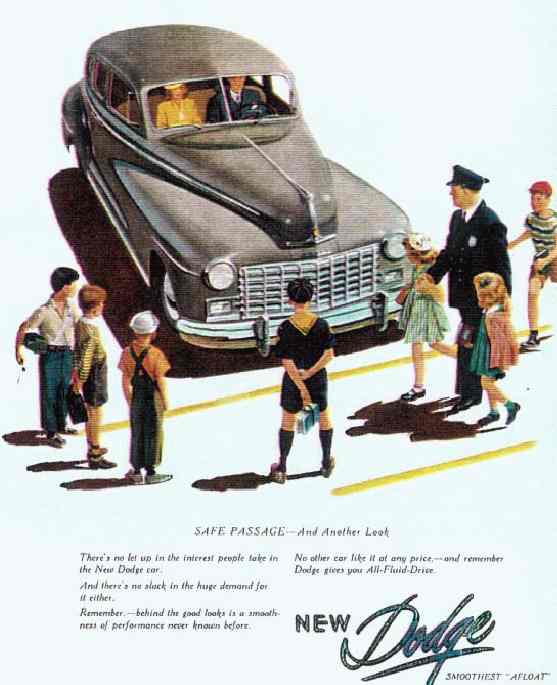
Advertisements: Dodge 1947

Figure 1.--The cars of the post-World War II era tended to be "warmed over" (that term is often used!) versions of the last 1942 models. They came out only a few months before Pearl Harbor. And were thus the last model year before automobile production was suspended for the duration of the War. Americans were eager for new appliances and automobiles after the war's end. They'd mended and made do with the old goods for years. The automobile
manufacturers reconverted factories away from wartime production to consumer production as soon as possible, but until 1948, most car makers served up cars that looked a bit dated. In the case of Chrysler Corporation, the maker of Dodges, the first really new, updated design didn't appear until March of 1949.
|
Automobile manufacturers attempt to sell many cars as family cars and family status sysmbols, thus many car ads picture children. An ad for a Dodge in 1947 showed the car stopped by a school crossing full of children. This illustrated what American children were wearing to school in 1947, at least at the beginning of the school year when the weather was still nice. One boy wears a Cub Scout uniform. This was also when the new car models were unveiled for the coming year. Not only is the children's clothing of interest, but also the great hulking Dodge which must have required a huge quanity of steel to produce is of interest.
Advertisement
Automobile manufacturers attempt to sell many cars as family cars and family status sysmbols, thus many car ads picture children. An ad for a Dodge in 1947 showed the car stopped by a school crossing full of children. The idea here is how the sparkling new car is attacting so much attention.
School Clothing
This illustrated what American children were wearing to school in 1947, at least at the beginning of the school year when the weather was still nice. There is quite a bit of information about school clothing here. One boy wears a Cub Scout uniform. The Cib wears the standard yelloe neckerchief. Boys wear a baseball cap and a Navy swabee cap. The boys wear a colared shirt as well as long=sleved polo shirt, anf and a "T" shirt. The boys wear boy long and short pants. One boy wears bib-front jeans. Except for the Cub Scout, on the children wear ankle socks.
Gender Image
One interesting aspect of this image is how differently the boys and girls are depicted. The girls are dressed very primly in dresses. One girl even has a bonnet. And unlike the boys, the policeman hasto take them by hand accross the street.
The Dodge
Not only is the children's clothing of interest, but also the great hulking Dodge which must have required a huge quanity of steel to produce is of interest. Deptember when school began was also when the new car models were unveiled for the coming year. Note how small rhe windows were. There were no wraparound windows. There event small sident vent windows. dIn addition the glass was not yer shatterproof. Perhaps some of our reades can tell us more about post-War Dodges.
vents
The cars of the post-World War II era tended to be "warmed over" (that term is often used!) versions of the last 1942 models. They came out only a few months before Pearl Harbor. And were thus the last model year before automobile production was suspended for the duration of the War. Americans were eager for new appliances and automobiles after the war's end. They'd mended and made do with the old goods for years. The automobile
manufacturers reconverted factories away from wartime production to consumer production as soon as possible, but until 1948, most car makers served up cars that looked a bit dated. In the case of Chrysler Corporation, the maker of Dodges, the first really new, updated design didn't appear until March of 1949. Studebaker unveiled a strikingly new car as early as
1947 (one auto critic wrote that you can't tell whether its coming or going from it's appearance), and Studebaker in its 1947 ads boasted that it was, "First by far with a postwar car!"
A reader writes, "You're right that by today's standards (with the exception of SUV's and the Hummer) these cars do seem ponderous. Also, the windshields, as HBC notes, were
not wraparound, and not until the 1953 models would both the front and rear windshields be singlepiece, rather than divided. Modern travellers would find these automobiles fairly spacious compared to today's cars, if a little higher and narrower than we're
accustomed to. Generous trunk space and a rear quarter window are nice. Safety features, however, are hard to find in these old models; no padded dashboards or instrument gauges (all hardmetal), and no seatbelts and harnesses. Were these old Dodges gas guzzlers? Not
as one might think. They didn't have modern fuel efficiency, but they were more economical than Chrysler cars of the 1960's and 1970's. Modern drivers might have other problems with the postwar Dodge. There was no power steering, so trying to parallel park this vintage vehicle will build upper body strength. That is, when you've found a parking space
these days large enough to accommodate your postwar Dodge! There is no accounting for
taste, it's said, and I like these old Dodges, De Sotos, and Chryslers.
Christopher Wagner

Navigate the Boys' Historical Clothing Web Site:
[Return to the Main advertisement page]
[Introduction]
[Activities]
[Biographies]
[Chronology]
[Clothing styles]
[Countries]
[Bibliographies]
[Contributions]
[FAQs]
[Glossaries]
[Satellite sites]
[Tools]
[Boys' Clothing Home]
Created: February 1, 2003
Last updated: February 2, 2003



